

Rupert Sheldrake ~ Morphic Resonance. Manipulating memory with light. Just look into the light: not quite, but researchers at the UC Davis Center for Neuroscience and Department of Psychology have used light to erase specific memories in mice, and proved a basic theory of how different parts of the brain work together to retrieve episodic memories.
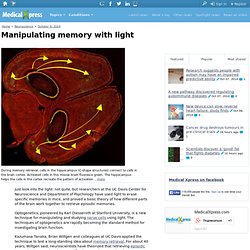
Optogenetics, pioneered by Karl Diesseroth at Stanford University, is a new technique for manipulating and studying nerve cells using light. The techniques of optogenetics are rapidly becoming the standard method for investigating brain function. Kazumasa Tanaka, Brian Wiltgen and colleagues at UC Davis applied the technique to test a long-standing idea about memory retrieval. Turning memories off with a flash of light. Using a flash of light, scientists have inactivated and then reactivated a memory in genetically engineered rats.
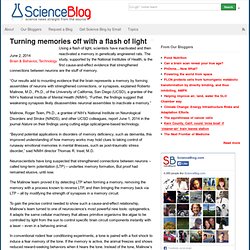
The study, supported by the National Institutes of Health, is the first cause-and-effect evidence that strengthened connections between neurons are the stuff of memory. “Our results add to mounting evidence that the brain represents a memory by forming assemblies of neurons with strengthened connections, or synapses, explained Roberto Malinow, M.D., Ph.D., of the University of California, San Diego (UCSD), a grantee of the NIH’s National Institute of Mental Health (NIMH). “Further, the findings suggest that weakening synapses likely disassembles neuronal assemblies to inactivate a memory.” Malinow, Roger Tsien, Ph.D., a grantee of NIH’s National Institute on Neurological Disorders and Stroke (NINDS), and other UCSD colleagues, report June 1, 2014 in the journal Nature on their findings using cutting edge optical/gene-based technology.
3D model of a nerve terminal in atomic detail. The electrochemical jelly inside your head contains something like one quadrillion synapses, the junctions at which nerve cells talk to one other by converting electrical signals into chemical ones and then back again.
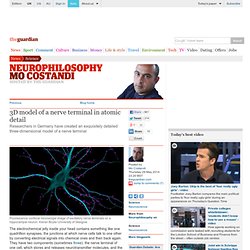
They have two components (sometimes three): the nerve terminal of one cell, which stores and releases neurotransmitter molecules, and the 'post-synaptic' membrane of another cell, which contains binding sites for the neurotransmitters. How Important Are Childhood Memories? Scientists Pinpoint Proteins Vital to Long-Term Memory. Low Levels of Omega-3 Fatty Acids May Cause Memory Problems. A diet lacking in omega-3 fatty acids, nutrients commonly found in fish, may cause your brain to age faster and lose some of its memory and thinking abilities, according to a study published in the February 28, 2012, print issue of Neurology, the medical journal of the American Academy of Neurology.
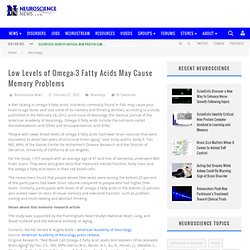
Omega-3 fatty acids include the nutrients called docosahexaenoic acid (DHA) and eicosapentaenoic acid (EPA). “People with lower blood levels of omega-3 fatty acids had lower brain volumes that were equivalent to about two years of structural brain aging,” said study author Zaldy S. Tan, MD, MPH, of the Easton Center for Alzheimer’s Disease Research and the Division of Geriatrics, University of California at Los Angeles. Scientists Create Novel Approach to Find RNAs Involved in Long-term Memory Storage. Neural Networks Forget Information Quickly. Researchers have figured out the speed that neural networks in the cerebral cortex can delete sensory information is a bit of information per active neuron per second.
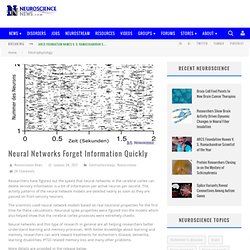
The activity patterns of the neural network models are deleted nearly as soon as they are passed on from sensory neurons. The scientists used neural network models based on real neuronal properties for the first time for these calculations. Neuronal spike properties were figured into the models which also helped show that the cerebral cortex processes were extremely chaotic. Neural networks and this type of research in general are all helping researchers better understand learning and memory processes. With better knowledge about learning and memory, researchers can work toward treatments for Alzheimer’s disease, dementia, learning disabilities, PTSD related memory loss and many other problems.
More details are provided in the release below. False Memories in Mice. Scientists have created a false memory in mice by manipulating neurons that bear the memory of a place.

The work further demonstrates just how unreliable memory can be. It also lays new ground for understanding the cell behavior and circuitry that controls memory, and could one day help researchers discover new ways to treat mental illnesses influenced by memory. In the study, published in Science on Thursday, the MIT scientists show that they can modify a memory and have a mouse believe it experienced something it didn’t. Susumu Tonegawa, a neuroscientist at MIT, and members of his lab used mice that were genetically modified to allow for certain neurons to be activated with a flash of light; the technique enabled the researchers to activate a memory that caused a mouse to believe it had experienced electrical shocks in a particular box, even though no such thing had happened there.
The science behind memory glitches. The Neuroscience of Regret. UCLA researchers discover that the sleeping brain behaves as if it's remembering something. Light brings back bad memories. A physiological marker for false memories. [VIDEO - VISUALISATION] Memory Threads. [VIDEO] BLUEMiND2: Where Nostalgia Is Born.